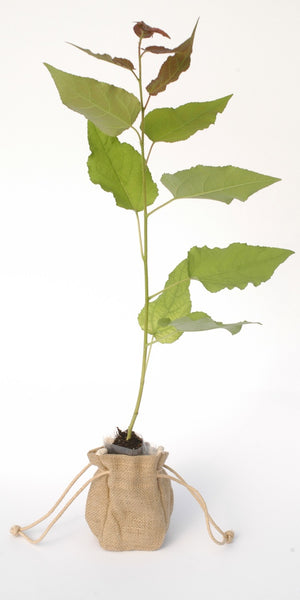Aspen Tree Facts and Information
- Latin: Populus tremulus
- Native words: Old Irish (critheann) Scots Gaelic () Old English () Welsh (aethnen or cryd,) eastern Celtic ()
- Ogham sign: EA
- Height when mature: 30m
- Height after 10 years: 8m

Aspen Trees botanical description:
The bark is of the aspen tree is grey, or sometimes greenish-grey, and is either smooth or in some cases is pitted with diamond-shaped indentations.
It has a distinctive branching pattern, which is most visible in winter when the tree is leafless, and in mature trees, the top branches are often bent over horizontally, which gives the tree a rather skeletal appearance.
Aspen Trees are often found growing near water in the wild and also on lowland streams and rivers.
The leaves are triangular on young trees and suckers becoming more oval the older the tree, and measure between 2.5 and 6 cm across. On young aspen suckers, the leaves are usually elongated and triangular in shape. The leaf stalks are flattened (on other trees they are round) and very flexible near the leaf blade. This gives rise to the characteristic fluttering of its leaves in a breeze. When the leaves first open in spring, they are a distinctive coppery colour, before turning green. In autumn, the leaves turn a vibrant yellow, or even red.
Aspen trees are either male or female (unlike most trees, where male and female flowers occur on the same tree). Trees flower in March and April, before the leaves appear, with both the male and female trees producing catkins; the female catkins are distinctively reddish.
Aspens usually spread not by seeds but by suckers, and often many appear at a time. Eventually, large stands of aspen develop with the descending in height from the original tree to the newest growing, and shortest suckers on the outer fringe farthest away. This is how whole aspen woods develop.
Like Birch (Betula spp.) and Rowan (Sorbus aucuparia), Aspen is a pioneer species - it is fast growing and regenerates profusely after disturbance. As in other pioneer species, an individual tree is short-lived, surviving for perhaps only 50-100 years, but the trees which grow from the suckers will carry on the genetic life of the original for centuries.
Aspen Trees natural history and ancient wisdom:

The Celts used Aspen for making shields, which were thought to have magical, protective, qualities to shield the bearer from harm. The magically protective nature of the 'shield tree' extended the whole community and Aspen, like the Rowan tree, was often planted close to a dwelling. Conversely, in the Western Isles, Aspen was not allowed to grow.
Being fairly water resistant, it was used for oars and paddles and sometimes clogs.
Leshy, a Slavic forest spirit is associated with the Aspen and was probably a woodland deity incarnated as an Aspen – in Eastern Europe whole Aspen woods can be found. He is rarely seen, but one can often hear him laughing, whistling, or singing; this must be related to the fact that the Aspen is usually heard before it’s seen, as its leaves rustle with the slightest breeze. He is most closely associated with the wolf. To call a Leshy, cut down an aspen tree so that it falls facing East. Bend over and look through your legs saying "Leshy, Forest Lord, come to me now; not as a grey wolf, not as a black raven, not as a flaming fir tree, but as a man." The Leshy will teach the magic arts to any whom he befriends. There is usually only one Leshy in each forest. He dies at the beginning of October and returns in the spring.
Aspen place names:
- Apps Court (Surrey)
- Apsley End (Bedfordshire), ‘aspen wood’
- Killiecrankie (Perthshire) ‘aspen wood’
- Aspull (Greater Manchester) ‘hill where aspens grow’.
Aspen Tree Wildlife Rating:
Excellent.
Aspen has a rich, specialised and unique fauna of insects fungi and lichens associated with it.
Aspen Trees Good Points:
- Drought sensitive and light-loving the Aspen is a good tree for a large garden, perhaps by a lake where the sight and sound of its shimmering leaves will relax any owner!
- It does not have a dense appearance and will let the light through well.
Aspen Tree Bad Points:
- Aspen does sucker profusely. Even when the tree is cut down the roots will send up suckers to regenerate.
Thinking about buying at Aspen Tree?
Here at Tree2 HQ, we specialise in sending trees as gifts. Our ancient wisdom trees are very popular as they each have a different meaning and symbol behind them.
A tree with a similar aesthetic to the Aspen would be our Silver Birch Tree Gift. The bark is an attractive pale white colour with dark fissure down the trunk and the tree canopy is light and wispy so will still let a lot of light into the garden when it's fully grown.
If you would like to order a large number of aspen saplings for a promotional project then please get in touch. Drop us an email at care@tree2mydoor.com and we will work with you to get a great idea together.